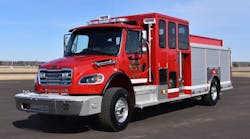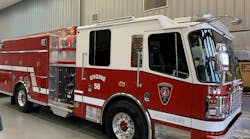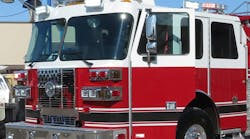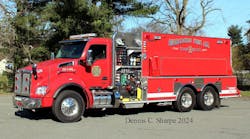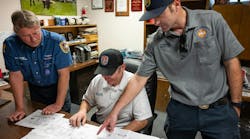Your first step should be to obtain a copy of the National Fire Protection Association (NFPA) 1901 Standard, 2003 edition (call the NFPA at 800-344- 3555). Next, familiarize yourself with the contents in Chapters 1 through 26, then turn to page 140 of Annex B.
Among other things, Annex B contains a 21-page questionnaire that mirrors the chapters in the main body of 1901. It’s filled with both basic and thought-provoking questions on what you and/or your apparatus committee would like to see (or expect) in the next “rig.” As an example, it asks if you want fender liners and does the apparatus need to be designed for off-road operation?
Be honest and answer using the combined knowledge and experience of your full committee. Believe me, if you spend the time here, your discussions with the representatives of the apparatus builders will go much smoother. Hint: you will save much time if you send a copy of the completed questionnaire to the reps before they come in to present their “dog and pony shows.”
Next, it would be a good time to determine whether you want a specific builder to construct this apparatus or are you required to write a general spec to attract multiple bidders? If you want a Seagrave, a Pierce, a Rosenbauer or whatever, AND you have the luxury of not having to go out to bid, do not spend the time and effort researching and writing a specification. Call in the manufacturer’s rep and negotiate a price for the apparatus and equipment you want. This will save everybody much time, money and aggravation.
However, if you are like the majority of fire departments, you are required to go out to bid for major purchases such as apparatus. This means researching and developing a spec that hopefully describes the vehicle that will meet your needs for now and for some time in the future.
All fire apparatus manufacturers have detailed specifications that describe specific apparatus in their lines. Generally, most departments take a builder’s spec and modify it to reflect local needs and desires. That’s a good start, as long as the basic spec includes all of the 1901 requirements for that type of rig.
Now, the “plot thickens.” NFPA 1901 is a basic spec; that is, it’s a place to start. From the 1901 basics, how you customize the spec will ultimately determine how well the unit satisfies the needs of your firefighters and your community. So, let’s take a look at some of the options or upgrades from 1901 that you may want to consider. We’ll start at the front bumper and move to the rear step. This list is not meant to be all inclusive. It’s just some suggestions I have from studying thousands of rigs over the past 40 years.
Front bumpers are now workstations on most rigs. I’ve seen front bumpers on rescue pumpers with two sets of rescue tools, including reels. At the very least, one or two pre-connects should be provided in this area supplied by two-inch or 21¼2-inch piping with storage for at least 100 feet of 11¼2-or 13¼4-inch hose for each discharge. Some departments substitute 100 or 200 feet of one-inch lightweight, single-jacket forestry line for one of the 13¼4-inch discharges.
Front suctions are popular in some areas, but if you want one, you need to investigate how to keep the elbows to a minimum when “snaking” the four- to five-inch piping to the front. A right side, low intake, in or on top of the gravel pan seems to offer the best water flow capabilities.
Warning lights on the front of the cab are the next area to consider. NFPA 1901 has some very specific requirements to ensure minimum lighting when both clearing or blocking the right of way. The best advice is to require the NFPA minimum lighting be from a single lighting manufacturer and then customize the rest according to your local desires.
Some East Coasters seem to prefer “Roto-Rays” while departments in California are required to have a steady burning red to the front. Alternating headlights are probably the most visible daytime warning devices. There are thousands of warning light options, so it is definitely something that you will want to research before you finish your spec.
A word about sirens and other audible devices. In 1991, the NFPA Apparatus Committee inserted requirements to move these noisemakers out front and down low to reduce the dBa levels in the cab. “Q” sirens are still quite popular, but you might consider the electronic versions to reduce the electrical amp draw. Both Federal and Whelen have electronic versions of the “Q.”
One of the more popular lights now being installed is the “brow light.” It is a very bright, white light at the top front of the rig to illuminate long lanes, low-hanging limbs or house numbers. New advances in 12-volt HID lights offer a viable alternative to the 120-volt, 500-1000 watt lights that were initially used.
Inside the cab, require red night lights in addition to the normal white ones. And, put all the aluminum clipboards, maps and other books in a cabinet that can be latched. Officers need to know how fast the vehicle is going; put a speedometer in front of them.
Most crew members like to ride facing the front, so accommodate them if you can. A raised roof in the cab facilitates easier entry and departures. Require windows at the back of the cab so firefighters can check out at the traffic before stepping down from the cab.
While in the cab, specify an electric adjustable driver’s seat (no more air ride seats) and also remote-controlled mirrors. A coil cord for the officer’s control of the air horn is a good option. DO NOT specify a lanyard for the driver’s air horn control. Drivers need to keep both hands on the wheel!
Mounting brackets for airpacks are well defined in the 2003 edition of 1901. However, some departments are now taking airpacks out of the cab to help ensure all persons stay seated and belted during a response.
Cab-mounted light towers are an excellent addition. There are good options available from several manufacturers (including Super Vac and Will-Burt). You will also want to have scene lighting on all four sides of the truck. The new 12-volt HID lights may reduce the need for a line voltage (120-240-volt) auxiliary power source. Speaking of line voltage, hydraulic-powered systems seem to be gaining popularity and work well for the five- to 15-kilowatt sizes. A gasoline- or diesel-driven generator is still the most popular way to provide line voltage.
Gear storage lockers are now available right behind the front doors of some custom cabs. These get the officer’s and driver’s gear out of the cab.
Vertical exhaust? Good idea, but it does take up some space in the pump area.
Conventional midship pumps continue to be primarily cast iron, heavy and space robbers. The good news is that there are plenty of options to consider for alternate designs and locations that save space and simplify plumbing. Perhaps the most popular is the rear mount, where a pedestal or end suction (the old front mount) pump is installed aft of the rear axle. They are driven by a drive shaft under the water tank from a PTO or a mid-ship mounted, split shaft, PTO drive. The new Phoenix ALF pumpers use this design in addition to having a midship engine (the power plant is out of the cab to remove engine noise and heat). Not only do the end suction pumps reduce the weight, they offer a great deal of flexibility in the location of the pump panel, valves and controls.
An ergonomically designed pump panel can be a big assist to your pump operators. Check out what’s available before you finalize the specs. Depending on your operational needs, you can specify a right, left or rear-mounted panel! A few suggestions before we leave the pump area. Specify a governor (Fire Research or Class 1), not a relief valve because they do more for the operator. Use electric controls (power) for all valves three inches or larger. Move the intakes and discharges away from the pump panel to provide engineers a clear area to operate. Consider a roll-up door to cover the panel to keep it clean and free of road grime.
Remote-controlled, pre-plumbed deluge guns (Akron or Elkhart) are terrific for rapid knockdowns and protecting exposures. With remote control, the engineer can operate both the pump and the gun from the pump panel. This frees up one firefighter and no one has to crawl up to the top of the truck to operate the device. This is a real safety PLUS!
Class A foam system? Do it and be sure the water tank has at least a minimum of a 30-gallon cell for foam concentrate. To keep everyone on the ground, specify a foam tank refill system that can transfer foam concentrate from cans at the pump operators position to the foam tank. This ups the safety factor at very little cost.
There are plenty of good, new, Class A proportioning systems available (Robwen, FoamPro and Darley, to name a few), but you should do your homework here. These packages and some good operator techniques saved quite a few homes in the latest California fires. No “Round-the-Pump” proportioning systems … PLEASE! They are too difficult to operate, provide erratic proportioning, and require a low inlet pressure be maintained when taking water from a hydrant or other pumpers.
For Class B operations (flammable liquid hazards), the entry-level system is still a line proportioner with a matching nozzle. For the larger hazards, good systems are available from a host of equipment manufacturers. Prepare to spend some “bucks” for the more sophisticated and flexible packages.
I have already mentioned pre-connects when discussing the front bumper area. Other considerations are to keep them low and easy to repack. Also, it is advisable to locate them near where the crew can get to them quickly.
Water tanks are now almost all made of polypropylene construction and the best builders back their products with lifetime guarantees. There is no reason to specify anything else. Consider adding a series of four lights to the side of the cab that tell at a glance how much water remains. These are controlled by the new generation, tank level instrumentation at the pump panel. These NEW instruments use transducers outside the tank to measure the weight of the water and they are very accurate. No more unloading the hose and removing the hosebed to get at a failed probe in the tank.
Moving on to the body, you should specify more than the minimum amount of reflective material (1901 requires a four-inch stripe on 50% of the sides and back and 25% of the front). There are lots of interesting designs for this. Just take a look at some of the apparatus deliveries and ads in Firehouse® and other fire magazines.
Roll-up doors eliminate pieces being torn off the rig (and butts being chewed) when leaving the station with the doors open. Roll-ups do take about six inches of space at the top of the compartment, but this is not that serious as this area is so high that we do not normally store things there. Most builders offer hinged or roll-up doors at the same price.
Most bodies are constructed of aluminum, but stainless steel is coming on fast. It adds weight (as compared with aluminum), but its durability has some real appeal. Where corrosion is not a problem, galvanneal is still the lowest-priced material being used.
Rescue-style bodies offer full-depth compartmentation as well as high sides on both sides of the apparatus. With rescue-type pumper bodies, ground ladder storage can be a challenge. Some builders tuck them on edge, next to the water tank, while others cut a tunnel through the tank for storage. A power fold-down ladder rack does not gobble up compartment space, but it does get a little pricey ($3,000 to $5,000). NOTE: require all ladders, especially the “A” frame type, to comply with NFPA 1932 requirements.
Consider specifying a stainless strip at the entrance of the compartments. It’s cheap, it looks good, and it protects the paint and/compartment material.
Aluminum hosebed covers are very popular, especially for departments that may operate in the wildland or urban interface. If you have a long hosebed, consider splitting it in half to reduce the weight of each door. Require a place to “pin” the doors when they are open so they can’t blow down on someone who may be in the hosebed. Don’t forget the 21¼2-inch blitz line in the hosebed. It should be pre-connected (perhaps with a new quick-attack, portable Akron Mercury-type monitor) for immediate deployment.
You also may want to look at low hosebeds like those in New York City. The advantage is the hose is very accessible and loading is much easier. It makes for an unusual-shaped booster tank, but then, who sees it?
Wheel pocket storage is another area whose “time has come.” With good planning, two or more air storage bottles or a large extinguisher can be placed fore and aft of the rear wheels.
At the back of the rig, place a light stick on the beavertail as high as possible, but protected from hose couplings being deployed from the hosebed. And consider using the Plano, TX-style, reflective chevron striping on the vertical areas. It’s always best to make the rear of the vehicle as visible as possible.
As I indicated at the beginning of this treatise, NFPA 1901 lists minimum requirements. It gives you a place to start. How you “build out” your spec is up to you and, to some extent, your budget.
Remember, safety is not the area in which to compromise. If you have to cut something, how about the bell or the CD player? OK, keep the bell and look elsewhere for the extras that you can live without.
Good luck and send me an e-mail if you have questions: [email protected].
R.J. “Bob” Barraclough has been associated with the fire service for 46 years. He was a volunteer firefighter in Pennsylvania for 25 years, a fire marshal (chief) on the USS Enterprise CVN-65, and a guest instructor at fire service meetings across the U.S. and Canada and also in Japan. Barraclough has served as a president of the Fire Apparatus Manufacturers’ Association (FAMA) and as an active member of the NFPA Apparatus Committee for over 20 years. A frequent writer on apparatus subjects, he is a consultant for several fire equipment manufacturers, and he provides technical advice in court cases involving apparatus.



















